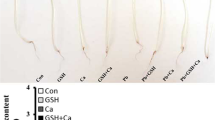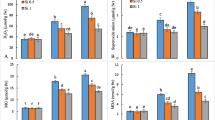Abstract
Effects of exogenous reduced glutathione (GSH) and cysteine (Cys) on growth, lead (Pb) accumulation, and nonprotein thiol (NPT) contents of Iris lactea var. chinensis under 100 and 500 mg L−1 Pb stress were studied. Our results showed that 500 mg L−1 Pb stress caused a dramatical decline in fresh weights, while the reduction of aboveground biomass was alleviated by exogenous GSH and Cys even though keeping higher Pb contents in roots and shoots. Exogenous GSH and Cys could enhance Pb accumulation in the shoots and roots compared with single Pb treatment. The promoting effect of GSH to Pb accumulation was larger than the effect of Cys, and the Pb contents in the shoots and roots treated with 500 mg L−1 Pb + GSH reached 1,712 and 14,603 mg kg−1, about 4.19 and 2.78 times of single 500 mg L−1 Pb treatment, respectively. Microscopic imaging of Pb in roots and leaves showed that higher intensive fluorescence was observed in cell wall of root epidermis, stele, vascular tissues of the roots, and sclerenchyma cells of leaves treated with 500 mg L−1 Pb + GSH and treated with 500 mg L−1 Pb + Cys. Exogenous GSH had an apparent promoting effect on root and shoot GSH synthesis, while exogenous Cys reduced the synthesis of cellular GSH in shoot and increased Cys contents. Pb only induced the synthesis of phytochelatin (PC)2 in roots, and the PC2 content declined in GSH- and Cys-treated plant roots. These results suggested that GSH synthesis was a more effective approach to improve Pb accumulation and translocation of I. lactea var. chinensis. Further analysis of protein expression in plants by exogenous GSH and buthionine sulfoximine (BSO) application showed that the proteins regulated by GSH and BSO may constitute various enzymes involved in GSH biosynthesis and play certain roles in Pb accumulation and tolerance of I. lactea var. chinensis.





Similar content being viewed by others
References
Antosiewicz D, Wierzbicka M (1999) Localization of lead in Allium cepa L. cells by electron microscopy. J Microsc 195:139–146
Bai WB, Li PF, Li BG, Fujiyama H, Fan FC (2008) Some physiological responses of Chinese iris to salt stress. Pedosphere 18:454–463
Bradford MM (1976) A rapid and sensitive method for the quantitation of microgram quantities of protein utilizing the principle of protein-dye binding. Anal Biochem 72:248–254
Cai Y, Cao FB, Cheng WD, Zhang GP, Wu FB (2011) Modulation of exogenous glutathione in phytochelatins and photosynthetic performance against Cd stress in the two rice genotypes differing in Cd tolerance. Biol Trace Elem Res 143:1159–1173
Chao YY, Hsu YT, Kao CH (2009) Involvement of glutathione in heat shock- and hydrogen peroxide-induced cadmium tolerance of rice (Oryza sativa L.) seedlings. Plant Soil 318:37–45
Chen F, Wang F, Wu FB, Mao WH, Zhang GP, Zhou MX (2010) Modulation of exogenous glutathione in antioxidant defense system against Cd stress in the two barley genotypes differing in Cd tolerance. Plant Physiol Biochem 48:663–672
Clemens S (2001) Molecular mechanisms of plant metal tolerance and homeostasis. Planta 212:475–486
Clemens S (2006) Evolution and function of phytochelatin synthases. J Plant Physiol 163:319–332
Dominguez-Solis JR, Lopez-Martin MC, Ager FJ, Ynsa MD, Romero LC, Gotor C (2004) Increased cysteine availability is essential for cadmium tolerance and accumulation in Arabidopsis thaliana. Plant Biotechnol J 2:469–476
Ebbs S, Lau I, Ahner B, Kochian L (2002) Phytochelatin synthesis is not responsible for Cd tolerance in the Zn/Cd hyperaccumulator Thlaspi caerulescens (J. & C. Presl). Planta 214:635–640
Freeman JL, Persans MW, Nieman K, Albrecht C, Peer W, Pickering IJ, Salta DE (2004) Increased glutathione biosynthesis plays a role in nickel tolerance in Thlaspi nickel hyperaccumulators. Plant Cell 16:2176–2191
Gisbert C, Ros R, De Haro A, Walker DJ, Bernal MP, Serrano R, Navarro-Avino J (2003) A plant genetically modified that accumulates Pb is especially promising for phytoremediation. Biochem Biophys Res Commun 303:440–445
Gong JM, Lee DA, Schroeder JI (2003) Long-distance root-to-shoot transport of phytochelatins and cadmium in Arabidopsis. Proc Natl Acad Sci U S A 100:10118–10123
Gopal R, Rizvi AH (2008) Excess lead alters growth, metabolism and translocation of certain nutrients in radish. Chemosphere 70:1539–1544
Gupta DK, Huang HG, Yang XE, Razafindrabe BH, Inouhe M (2010) The detoxification of lead in Sedum alfredii H. is not related to phytochelatins but the glutathione. J Hazard Mater 177:437–444
Gupta DK, Huang HG, Corpas FJ (2013) Lead tolerance in plants: strategies for phytoremediation. Environ Sci Pollut Res 20:2150–2161
Haydon MJ, Cobbett CS (2007) Transporters of ligands for essential metal ions in plants. New Phytol 174:499–506
Han YL, Yuan HY, Huang SZ, Guo Z, Xia B, Gu JG (2007) Cadmium tolerance and accumulation by two species of Iris. Ecotoxicology 16:557–563
Han YL, Huang SZ, Gu JG, Qiu S, Chen JM (2008) Tolerance and accumulation of lead by species of Iris L. Ecotoxicology 17:853–859
Jabeen R, Ahmad A, Iqbal M (2009) Phytoremediation of heavy metals: physiological and molecular mechanisms plants growing in contaminated soils. Bot Rev 75:339–364
Kopittke PM, Asher CJ, Blamey FP, Auchterlonie GJ, Guo YN, Menzies NW (2008) Localization and chemical speciation of Pb in roots of signal grass (Brachiaria decumbens) and Rhodes grass (Chloris gayana). Environ Sci Technol 42:4595–4599
Laemmli UK (1970) Cleavage of structural proteins during the assembly of the head of bacteriophage T4. Nature 227:680–685
Lu LL, Tian SK, Yang XE, Wang XC, Brown P, Li TQ, He ZL (2008) Enhanced root-to-shoot translocation of cadmium in the hyperaccumulating ecotype of Sedum alfredii. J Exp Bot 59:3203–3213
Malecka A, Piechalak A, Morkunas I, Tomaszewska B (2008) Accumulation of lead in root cells of Pisum sativum. Acta Physiol Plant 30:629–637
Mishra S, Srivastava S, Tripathi RD, Kumar R, Seth CS, Gupta DK (2006) Lead detoxification by coontail (Ceratophyllum demersum L.) involves induction of phytochelatins and antioxidant system in response to its accumulation. Chemosphere 65:1027–1039
Nishikawa K, Onodera A, Tominaga N (2006) Phytochelatins do not correlate with the level of Cd accumulation in Chlamydomonas spp. Chemosphere 63:1553–1559
Noctor G, Gomez L, Vanacker H, Foyer CH (2002) Interactions between biosynthesis, compartmentation and transport in the control of glutathione homeostasis and signalling. J Exp Bot 53:1283–1304
Noctor G, Mhamdi CS, HAN Y, Neukermans J, Marquez-Garcia B, Queval G, Foyer CH (2012) Glutathione in plants: an integrated overview. Plant Cell Environ 35:454–484
Pawlik-Skowronska B (2002) Correlations between toxic Pb effects and production of Pb-induced thiol peptides in the microalga Stichococcus bacillaris. Environ Pollut 119:119–127
Phang IC, Leung DWM, Taylor HH, Burritt DJ (2011) Correlation of growth inhibition with accumulation of Pb in cell wall and changes in response to oxidative stress in Arabidopsis thaliana seedlings. Plant Growth Reg 64:17–25
Piechalak A, Tomaszewska B, Baralkiewicz D, Malecka A (2002) Accumulation and detoxification of lead ions in legumes. Phytochemistry 60:153–162
Qiu BY, Zeng FR, Cai SG, Wu XJ, Haider SI, Wu FB, Zhang GP (2013) Alleviation of chromium toxicity in rice seedlings by applying exogenous glutathione. J Plant Physiol 170:772–779
Rossato LV, Nicoloso FT, Farias JG, Cargnelluti D, Tabaldi LA, Antes FG, Dressler VL, Morsch VM, Schetinger MRC (2012) Effects of lead on the growth, lead accumulation and physiological responses of Pluchea sagittalis. Ecotoxicology 21:111–123
Seth CS, Remans T, Keunen E, Jozefczak M, Gielen H, Opdenakker K, Weyens N, Vangronsveld J, Cuypers A (2012) Phytoextraction of toxic metals: a central role for glutathione. Plant Cell Environ 35:334–346
Sharma P, Dubey RS (2005) Lead toxicity in plants. Braz J Plant Physiol 17:35–52
Singhal RK, Anderson ME, Meister A (1987) Glutathione, a first line of defense against cadmium toxicity. FASEB J 1:220–223
Sneller FEC, Van Heerwaarden LM, Kraaijeveld-Smit FJL, Ten Bookum WM, Koevoets PLM, Schat H, Verkleij JAC (1999) Toxicity of arsenate in Silene vulgaris, accumulation and degradation of arsenate-induced phytochelatins. New Phytol 144:223–232
Sun Q, Wang XR, Ding SM, Yuan XF (2005) Effects of exogenous organic chelators on phytochelatins production and its relationship with cadmium toxicity in wheat (Triticum aestivum L.) under cadmium stress. Chemosphere 60:22–31
Sun Q, Ye ZH, Wang XR, Wong MH (2007) Cadmium hyperaccumulation leads to an increase of glutathione rather than phytochelatins in the cadmium hyperaccumulator Sedum alfredii. J Plant Physiol 164:1489–1498
Tennstedt P, Peisker D, Bottcher C, Trampczynska A, Clemens S (2009) Phytochelatin synthesis is essential for the detoxification of excess zinc and contributes significantly to the accumulation of zinc. Plant Physiol 149:938–948
Vogeli-Lange R, Wagner GJ (1996) Relationship between cadmium, glutathione and cadmium-binding peptides (phytochelatins) in leaves of intact tobacco seedlings. Plant Sci 114:11–18
Waranusantigul P, Lee H, Kruatrachue M, Pokethitiyook P, Auesukaree C (2011) Isolation and characterization of lead-tolerant Ochrobactrum intermedium and its role in enhancing lead accumulation by Eucalyptus camaldulensis. Chemosphere 85:584–590
Wong CKE, Cobbett CS (2009) HMA P-type ATPases are the major mechanism for root-to-shoot Cd translocation in Arabidopsis thaliana. New Phytol 181:71–78
Yuan HY, Huang SZ, Han YL, Guo Z (2013) The growth, lead accumulation and oxidative stress response of Iris lactea var. chinensis under lead stress. Fresen Environ Bull 22:1887–1894
Yuan HY, Guo Z, Huang SZ (2011) Effects of Pb on growth, heavy metals accumulation and chloroplast ultrastructure of Iris lactea var. chinensis. Acta Ecologica Sinica (in China) 31: 3350–3357
Zhang ZC, Chen BX, Qiu BS (2010) Phytochelatin synthesis plays a similar role in shoots of the cadmium hyperaccumulator Sedum alfredii as in non-resistant plants. Plant Cell Environ 33:1248–1255
Zheng LJ, Peer T, Seybold V, Lutz-Meindl U (2012) Pb-induced ultrastructural alterations and subcellular localization of Pb in two species of Lespedeza by TEM-coupled electron energy loss spectroscopy. Environ Exp Bot 77:196–206
Zhu YL, Pilon-Smits EAH, Tarun AS, Weber SU, Jouanin L, Terry N (1999) Cadmium tolerance and accumulation in Indian mustard is enhanced by overexpressing γ-glutamylcysteine synthetase. Plant Physiol 121:1169–1178
Acknowledgments
This work was supported by projects from the Natural Science Foundation of China (No. 31300436), Jiangsu Provincial Agricultural Science and Technology Support Program (BE2012349), and National Science and Technology Major Project (No. 2012ZX07101-005).
Author information
Authors and Affiliations
Corresponding author
Additional information
Responsible editor: Philippe Garrigues
Rights and permissions
About this article
Cite this article
Yuan, H., Zhang, Y., Huang, S. et al. Effects of exogenous glutathione and cysteine on growth, lead accumulation, and tolerance of Iris lactea var. chinensis . Environ Sci Pollut Res 22, 2808–2816 (2015). https://doi.org/10.1007/s11356-014-3535-y
Received:
Accepted:
Published:
Issue Date:
DOI: https://doi.org/10.1007/s11356-014-3535-y




